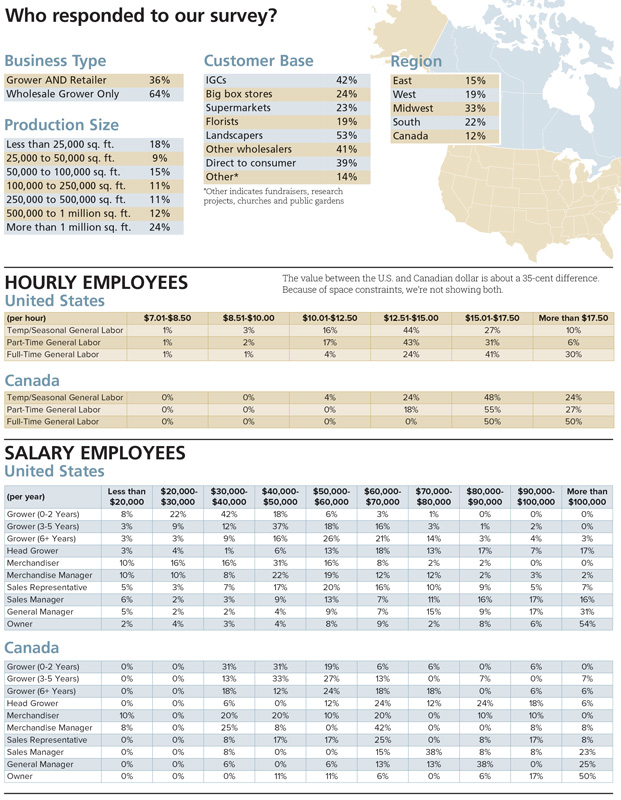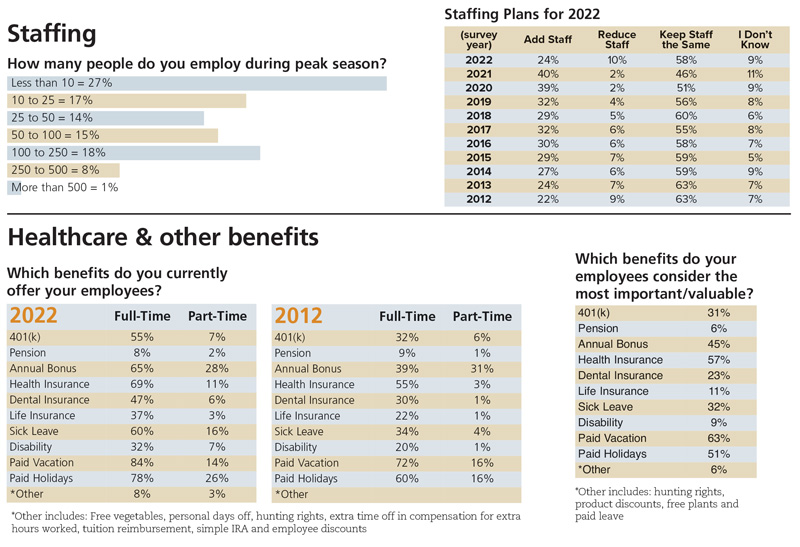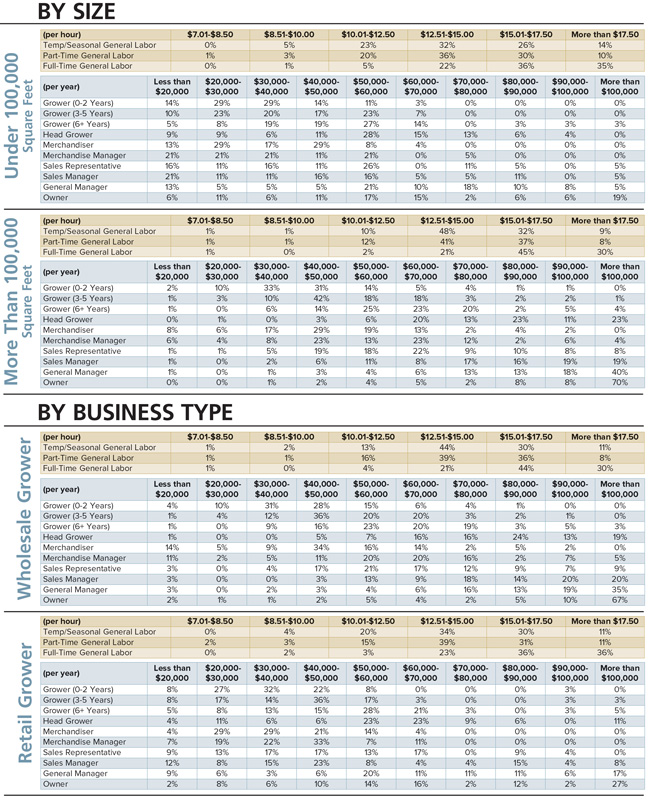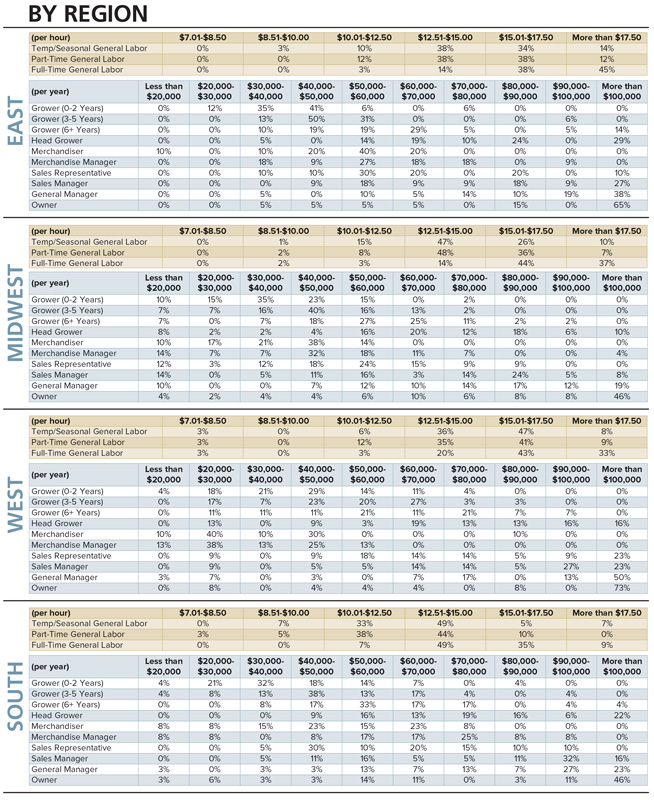12/1/2022
Wages: Onward & Upward
Compiled by Jennifer Zurko, Chris Beytes & Paul Black

After we sent out the request for you, our dear readers, to take our now 27th annual Wage & Benefit Survey, one of our close industry friends asked why we don’t just take away the $7.01 to $8.50 category from the hourly employees section.
“Nobody pays that low a wage anymore,” he said.
We thought, “That’s a good question,” so we did a little digging. We checked back from a few random years to see if there was a pattern and we definitely found one. For the main type of employee that growers need during peak—and are currently the hardest to find—wages for Temp/Seasonal General Labor have gone up significantly. In 2013, 38% of growers in the U.S. paid seasonal labor $7.01 to $8.50. This year, it’s 1%.
Wages for Full-Time General Labor in the U.S. also went up—for those making $15 or more, it was 8% in 2013; this year, it’s 71%. And if you look at those making more than $17.50, it wasn’t as high, but definitely trending upward. (We didn’t even ask as high as $17.50 in 2013 and 2018.)
You’re also paying other positions more, including entry-level growers with two years or less of experience, head grower—and even owners are making more than compared to 2013. (See the breakdown in the charts.)
Temp/Seasonal General Labor (U.S.) making $7.01 to 8.50:
2022 – 1%
2021 – 3%
2020 – 5%
2018 – 10%
2013 – 38%
Full-Time General Labor (U.S.) making $15 or more:
2022 - 71%
2021 – 54%
2020 – 47%
2018 - 27%
2013 – 8%
Full-Time General Labor (U.S.) making more than $17.50:
2022 – 30%
2021 – 20%
2020 – 17%
2018 – *
2013 – *
*$15 or more was our top category
Grower – 0-2 Years (U.S.) Making $40,000 or more:
2022 – 33%
2021 – 29%
2020 – 23%
2018 – 28%
2013 – 6%
Grower – 0-2 Years (U.S.) making $50,000 or more:
2022 – 20%
2021 – 8%
2020 – 6%
2018 – 9%
2013 – 3%
Head Grower (U.S.) making $80,000 or more:
2022 – 51%
2021 – 23%
2020 – 22%
2018 – 20%
2013 – 13%
Owner (U.S.) making $100,000 or more:
2022 – 54%
2021 – 36%
2020 – 42%
2018 – 39%
2013 – 26%
Obviously, a lot of factors have contributed to this pattern we’ve been seeing for a few years now: minimum wage increases in many states and counties around the country, and more competition for workers from other industries.
But some of our respondents said that their employees are also asking for better compensation. The last question is always open-ended, and this year we asked: Where have you had success finding new employees? And what creative incentives have worked for attracting and/or keeping good employees?
For those who responded, there were three things that were mentioned repeatedly: flexible schedules, more compensation and the use of jobs sites, like Indeed. Some notable comments were:
“Employees like more compensation and flexible schedules.”
“Be competitive on wages.”
“Good pay and treating them as family.”
“Word of mouth [is] still the most successful. Both with finding GOOD people [and] people who want to work rather than have to.”
“Treating everyone equal no matter what position they hold and treating them like I would want to be treated.”
“We don't have any particularly creative incentives; we just try to provide a respectful work environment with good pay plus overtime.”
So it would seem that good wages are only part of the recipe for hiring and retaining good employees—a good working environment needs to be part of the mix, too.
Other ways growers are trying to find workers included:
• Social media
• Hiring foreign-born employees and seniors
• Local advertising
• Local ads
• Local university
• Local temp agency
• Using contract workers
• Employee referrals
• Community outreach
• Career fairs
Simple Courtesy
By Bob Zahra
Executive search consultant Michael Garnes said, “There are two types of people in the world: givers and takers.”
There are also the courteous and the discourteous, the polite and the impolite, individuals with good manners and those with bad manners. A continuum connects the disparate poles between courteous and discourteous, good and bad, etc.
Emily Post said, “Manners are a sensitive awareness of the feelings of others. If you have that awareness, you have good manners, no matter what fork you use.”
Why is simple courtesy a topic worthy of consideration under the umbrella of hiring (and being hired) in the greater horticulture industry? A person could argue convincingly that in the last 10 years certain national leaders have made it a point to lead our country to repudiate traditional courtesy and traditional good manners, arguing that toughness alone has primacy.
Here’s a question: Is the candidate who’s interviewed as a likely new employee in your company treated with the same respect as the possible new customer? How the hiring authority interacts with a candidate says much about the hiring authority and even more about the company, and it can be argued that the potential, excellent, long-term employee is every bit as important to the company’s future as the possible new customer—in many cases more so. Both should be treated thoughtfully, respectfully and courteously. Toughness has its place in the overall picture, but not at the expense of good will and simple courtesy.
As a candidate in pursuit of career advancement, do you respond promptly or are you casual about keeping your commitments to the hiring authority? As Ms. Post wrote, do you have a “sensitive awareness to the feelings of others?” Being reliable, doing what you say you’ll do, is inextricably tied to “hireability” and promotability. The days of innumerable horticulture employment options for the upwardly mobile may be upon us now, but—for the same reason stock market charts don’t point straight up year after year—neither does hiring. The wise person recognizes the inherent short-lived nature of life-changing employment opportunities and is prepared to seize immediately the most advantageous. It can take a lifetime for an incumbent industry leader to retire.
Of all the positive things one could say about Johnny Carson—funny, intelligent, talented, perfect posture, great dresser—comedian Steve Martin said, “Johnny was polite.”
The talented industry individuals who are discourteous, who are unthoughtful or are insensitive to the feelings of others, will not reach their true potential. They may retire happily right where they are, but they’re unrecruitable and unpromotable. They won’t come close to achieving the contribution of the people for whom they work.
On the other hand, it’s altogether possible to drive a hard business bargain, while at the same time remaining polite and courteous. In this small town we call the international horticulture industry, all of us will continue to bump into each other throughout our careers and it seems wise to plan accordingly.
Bob Zahra is an executive search consultant with Florasearch, Inc., a certified personnel consultant, and past chair of the National Association of Executive Recruiters. He can be reached at (407) 320-8177 or bzahra@florasearch.com. Visit www.florasearch.com.



